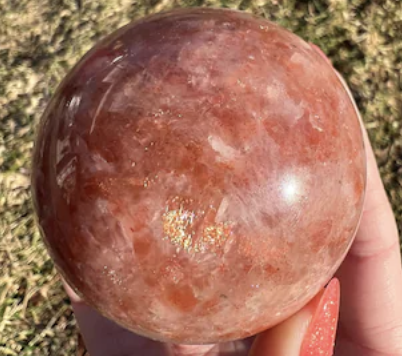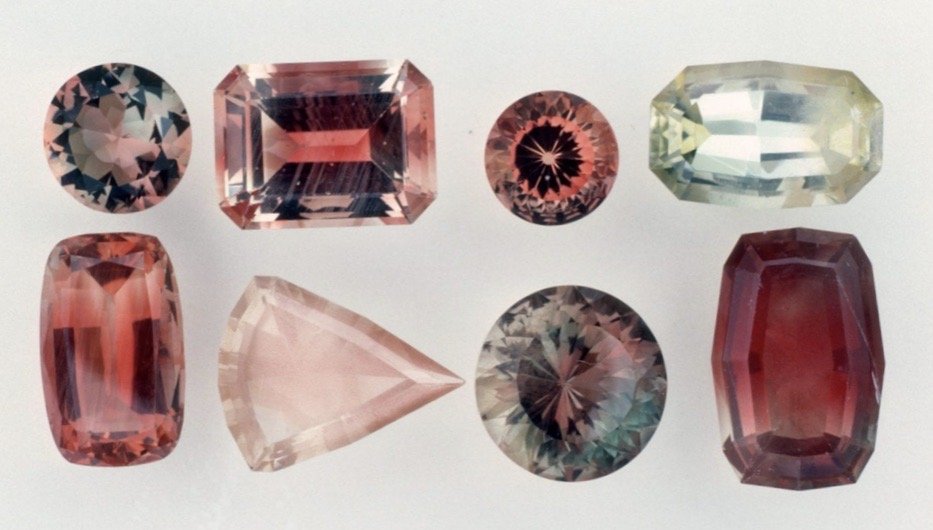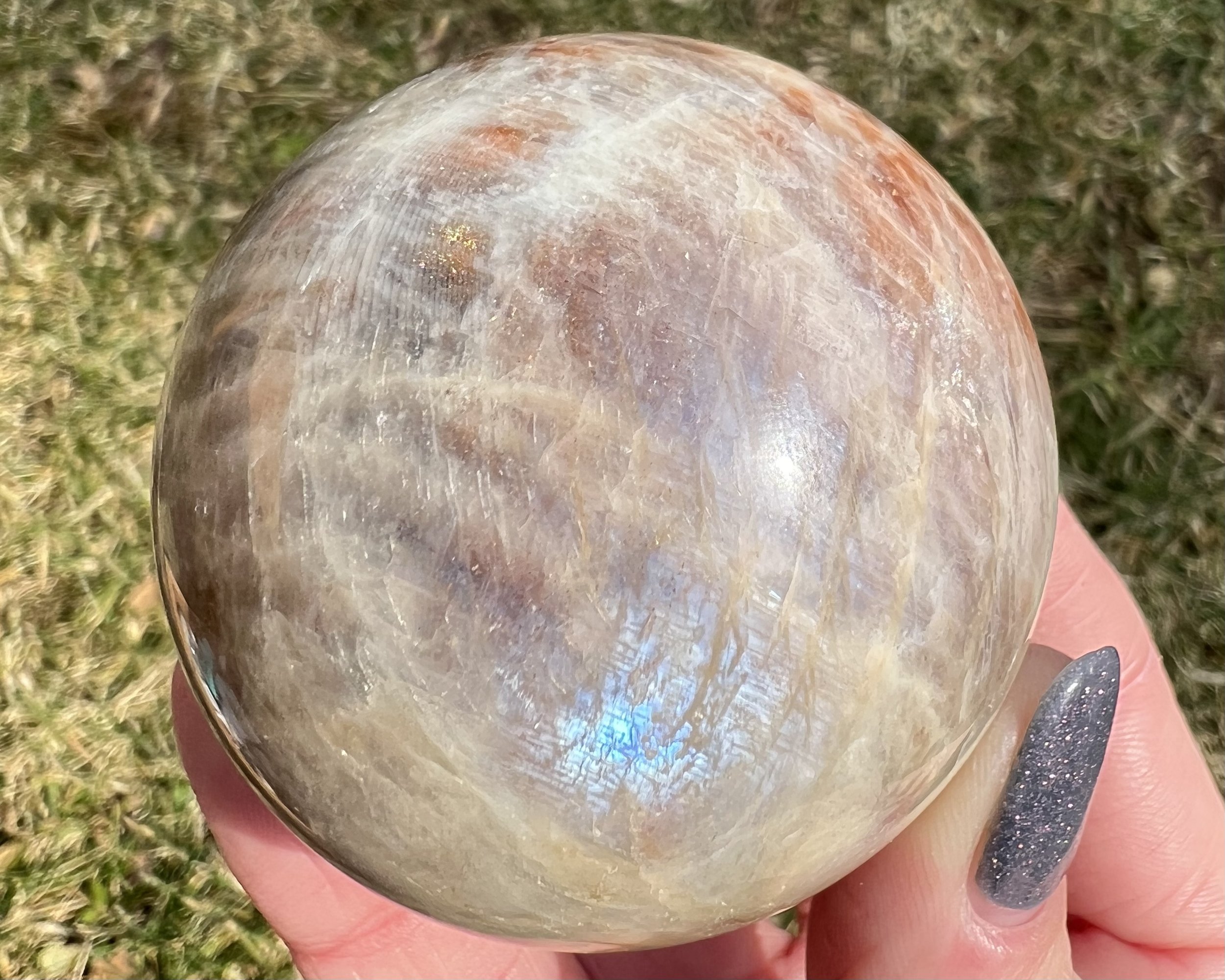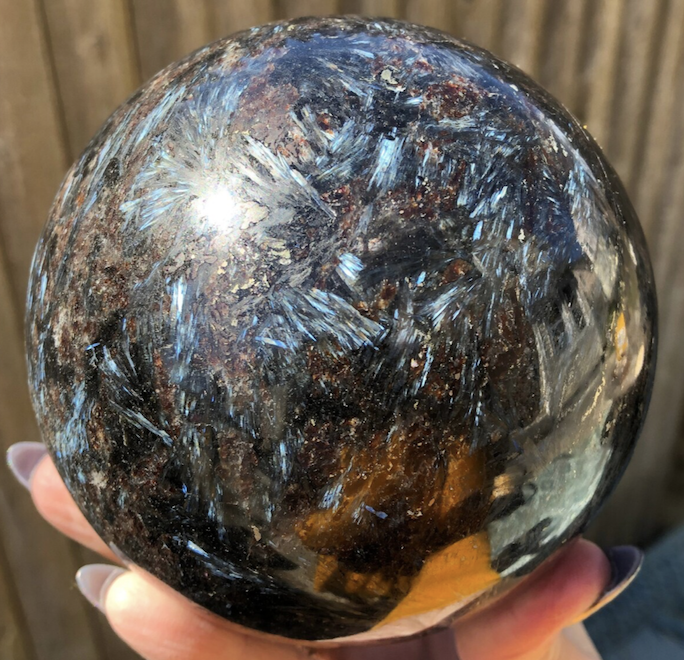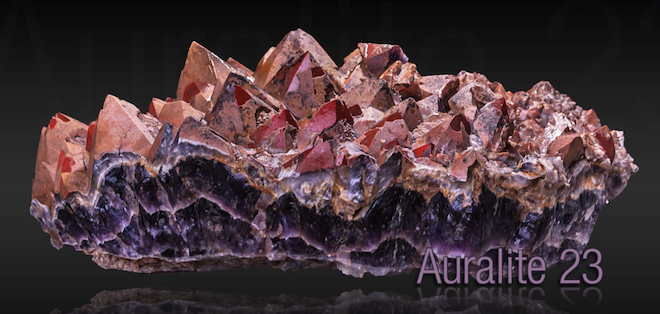
Sunstone and Sunstone and Sunstone
If you look up Sunstone in a google search, you will see many stones that vary wildly in appearance. That is because not all Sunstones are quite the same stone. There are three main types of Sunstones. One is usually mostly orange and more opaque and often has sparkly stuff in it. Another has more sparkles, more rainbows and less orange. The last is more transparent to translucent and may even change colors. They are all feldspars, and have inclusions that cause Aventurescence (also known as schiller) which is "sparkly, metallic-looking luster caused by flat, reflective inclusions" according to GIA. Their mineralogical name is Aventurine Feldspar. Beyond that, these stones have lots of differences.
The Sunstone most commonly seen by the average crystal enthusiast is probably the bright sparkly varieties of the Oligoclase and Orthoclase Feldspar groups. One Oligoclase Feldspar type of Sunstone you've probably seen is from India, cut and polished into spheres and hearts and palm stones. They have bright orange color with shiny Hematite platelets in a variety of colors that give it the trade name "Confetti Sunstone." There are similar varieties of this Sunstone from around the world including Tanzania and Canada.
In Australia, there is a type of Orthoclase Sunstone with long shiny plates of Hematite and Magnetite with rainbow iridescence that can intersect, lovingly called "Rainbow Lattice Sunstone." In these Sunstones the inclusions are hosted in a more translucent or even transparent Orthoclase that shows off the beautiful inclusions in them. In the bottom of this image is another example of an Orthoclase Sunstone- this one from Russia, where the plates are short and hexagonal but also very colorful.
The third type of Sunstone is most famously called Oregon Sunstone. It is the official state gemstone of Oregon. It is technically a type of Labradorite which has Copper inclusions (rather than Hematite ones) that cause its aventurescence. The first recorded occurrence of these stones was by Native Americans who used them in trade and sometimes buried them with their dead. Some Oregon Sunstones have pleochroism, or change colors at different angles. They occur in a range of colors including orange, red, yellow, green and blue.
These Sunstones are the only kind that are faceted often. In the late 1800s Tiffany & Co owned the first commercial mine for Oregon Sunstones which they marketed as "Plush Diamonds" but it didn't catch on as well as they'd hoped and at some point later on they sold the claims. Sunstones are not as popular as other stones in jewelry, but their natural beauty tends to capture the hearts of those who see them up close and in person.
There are mentions of a "sunstone" used by Vikings to navigate the seas in cloudy weather before the invention of the magnetic compass. This "sunstone" however was not Sunstone. We don't know for sure what stone they were using, but a shipwreck from the English Channel that sank in the 1500s had a crystal among its navigation tools, a piece of Optical Calcite- also called Iceland Spar- which is known for its diffraction of light. Many believe that it was pleochroic Iolite, which changes color depending on the angle of light as shown here. Both could be used to determine the position of the sun.
I hope you enjoyed my explanation of Sunstones! You can find several kinds of Sunstones including Rainbow Confetti Sunstones and even Moonstone & Sunstone together, in my Etsy shop. Thanks for reading! -Shawna
Arfvedsonite or Astrophyllite? Neither!
I’ve seen this same stone popping up at trade shows and supplier warehouses for years now, with several different names. Many suppliers call it “Fireworks Stone,” I see lots of it online sold as “Astrophyllite” or “Arfvedsonite.” I’ve seen lots of metaphysical sites comparing the two and proclaiming them to be one or the other. I have spent a long time trying to figure it out and in the past have settled for calling it Arfvedsonite just because I have to call it something. But there are many inconsistencies with those labels when it comes to the stone in question.
First the easiest one - “Fireworks Stone” is not a name of any mineral accepted by any reputable mineral or gem organization. It doesn’t mean anything and doesn’t tell us anything about what it actually is or the minerals in it. We call this a marketing or trade name - someone made it up to sell more rocks because it sounded cool or they didn’t actually know what kind of stone it was- or both.
Next, Astrophyllite. It forms gold, iridescent sprays much like the ones seen in the material in question. However, according to Mindat its color is “bronze-yellow, golden yellow, brown to reddish brown.” The stones that I have seen of the mystery material often have more blue than gold and yellow. Sometimes they are more gold too, but it cannot be Astrophyllite when so much of this material is so very blue. Astrophyllite also occurs more in radial “sun” shapes which often form full circles. Our mystery stone forms more often in “brush” shapes like a paintbrush pressed against a surface.
The third contender is Arfvedsonite. This is what I most commonly see this stone called online. If you post it in a mineral ID group, there will always be someone (never one of the geologists or mineralogists) who jumps to argue that it is Arfvedsonite. Mindat says the color of Arfvedsonite is “bluish-black to black” and in their gallery of 225 photos of Arfvedsonite specimens, all of them look closer to a Black Tourmaline than the material we are trying to identify. Every photo from a reputable source appears much like this photo - very dark or black crystals. Nothing iridescent gold or blue at all.
Finally after many hours spread over several years down this rabbit hole I believe I have found the answer. The name of the mineral in question is Anthophyllite. Anthophyllite is a fibrous amphibole mineral. It is also iridescent but can have gold, yellow, green, blue, and brown - so the iridescence of Anthophyllite fits much better than either of the other minerals it is often called.
On Mindat, there is a photo in the gallery for Anthophyllite that very much resembles the mystery material. It is labeled “Anthophyllite, Garnet, Cordierite.” The piece that I currently have does appear to have a lot of sparkly Almandine Garnet, which makes it a much more believable identification than other minerals. I have often seen the red part of this material called Eudialyte, but none of the aforementioned minerals appear to occur much in association with Eudialyte. My guess is that someone assumed it to be Eudialyte because that is a red mineral associated with Astrophyllite. Anthophyllite, on the other hand has both Garnet and Cordierite listed under common associates.
Another mineral listed under Anthophyllite’s common associates is Gedrite. This is interesting because Gedrite looks pretty similar to Anthophyllite, occurring in fibrous sprays, but is mostly black or dark green. The photo on the left here is Gedrite with Garnet. In the material I have now, shown on the right, there is a lot of shiny black sprays that are around the golden ones, and Anthophyllite and Gedrite do indeed occur together. Random fun fact- Gedrite and Anthophyllite alone together have a trade name you’ve probably heard before - Nuummite!
I found an article on Epigem that talks about this stone pictured, found in Sweden and described as an Anthophyllite schist “with reddish brown garnet, granular epidote and colorless cordierite.” This makes so much sense because so many of the pieces of this material I’ve had also had bits of green in them, and the one I’m looking at now does have some areas of clear stone that appears to sparkle similar to other cordierites I have had. In comparison, Cordierite does not often occur with Arfvedsonite, which mostly forms on Feldspars. It is also not listed as an associated mineral of Astrophyllite. So again, it seems that Anthophyllite is the most likely identification of these no-longer mysterious iridescent blue and gold sprays.
Crystal Names™ to Be Mindful Of
Super Seven. It sounds simple enough. It means that it has a combination of 7 minerals- Amethyst, Smoky Quartz, Quartz, Cacoxenite, Lepidocrocite, Rutile, and Goethite. It is also called Melody Stone™. Let’s start with the easiest problem with this claim. Amethyst, Smoky Quartz and clear Quartz are all variations of one mineral - Quartz. So are Citrine and Rose Quartz. They are not separate minerals.
There are also two inclusions in this list that pose quite the conundrum- both Cacoxenite and Lepidocrocite have been disproven to occur in Quartz by laboratory analysis. Cacoxenite in Quartz is actually Goethite. Often lustrous, golden colored and occurring in fan-like sprays.
Our next imposter is Lepidocrocite, which in any Quartz is actually Hematite. Hematite occurs in many forms, in many different colors, in many different locations all over the world, and looks a lot of different ways. Another popular one that is often mislabeled is the “Strawberry Quartz” of Orange River and Namibia, especially the Brandberg area. Yet again these are Quartz and Amethyst with Hematite.
That brings 3 of our minerals down to one, and the other 4 down to 3, though one is changed. We have Quartz, Hematite, Goethite and Rutile. Maybe they should re-trademark it Super Four. Melody holds the trademark for “Super Seven™,” a made up marketing term to make more money on anything they can. "Auralite 23™” is the Canadian version, with an even more ridiculous list of supposed inclusions.
Robert Simmons is another person who loves to trademark any stone he can get enough of to market under a new name and charge ridiculous prices for them. This not only makes crystals cost more for everyone, but confuses many on what they actually are. Azeztulite™ (low grade Quartz from anywhere convenient to Robert Simmons), Healerite™ (lighter green Serpentine), Blue Moon Quartz™ (Dumortierite Quartz), Agnatite™ (Red Hematoid Quartz from Madagascar), Anazez™ (Chevron Amethyst from Africa), Transmutite™ (Petrified Wood from Nevada) and Cinnazez™ (Cinnabar and Zinc in Quartz) are a few of the stones they have re-named with trademarks.
Another problem that this causes is that online sellers like myself often need to included these fake names in our titles and listings because we need to use the names that people are familiar with and using to search for them, which further perpetuates the use of these names. There are many of them, not all are trademarked. Many are just made up, bad translations, or mislabeled names that have become more popular than the stone’s true name.
In the end, you can believe that Azeztulite is a special Quartz blessed by the Azez Angelic entities but it seems pretty sus that it (and many of his trademarked stones) happen to come from the places that Robert Simmons has lived. You can pay hundreds of dollars for a small piece of low grade, cheap stone if you want to, I won’t stop you. But information is power, and being informed about the stones you buy is important for all buyers of crystals whether you own a handful or a houseful. I hope you find this information helpful.
Thank you,
Shawna
Kouva Dream Catchers and Crystals
Crystals for Anxiety
What crystals can we use to help with Anxiety?
Let’s talk about Lithium.
You’ve probably heard of Lithium at some point. It’s a type of drug used to treat Bipolar Disorder in people who haven’t responded to other medications. It’s also a Nirvana song and has been referenced in pop culture for decades in association with depression and mental illness. You’ve surely heard of Lithium batteries too, which have a high energy density and are often used in small items such as hearing aids, pacemakers, and car lock remotes. So what the heck is Lithium?
Lithium is an element, a soft metal that is always found in other minerals. It was first discovered on the Swedish island Utö, by Jozé Bonifácio de Andralda e Silva, who was a Brazilian naturalist, in the 1790s. He discovered there the mineral Petalite, which gave off a bright red flare when put in fire. It was not until 1817 that a chemist discovered that Petalite contained a previously unknown element - Lithium.
Lithium is always found within other minerals, like its first discovery in Petalite. It had many uses over the years - several that were highly unsuccessful- but starting in the 1870s it was used to treat mania and other “mood disorders,” though people understood very little about Lithium or mental illness at that time. Lithium is still used in modern psychiatric treatments today, especially for bipolar, depression and schizophrenia.
Lithium-bearing stones and crystals are great tools for anxiety as well. Let's take a look at some of the types that contain the element Lithium.
One of the most popular is Lepidolite. Lepidolite is usually purple, sometimes pink colored Mica that has Lithium in it. It is great for relieving stress and anxiety. Lepidolite comes from the Greek word lepidos, meaning 'scale,' because it balances emotions and looks like the scales of a dragon or beautiful fish. Lepidolite is used for calm sleep and dreams, and to dissolve any negative energy blocks you may have.
Lithium Quartz, of course, is Quartz with Lithium inclusions. It often appears as soft pink or mauve colored clouds or phantoms inside clear Quartz crystals. Lithium Quartz is used to lift your vibration upward gently. It gives you tranquil clarity and makes you feel at peace, and ready to heal. It is good for lessening depression or the intensity of heartbreak.
Tourmaline often contains Lithium, and Lithium-rich Tourmalines can be be just about any color- including pink, blue, green, yellow, red et cetera. Tourmaline releases stress and worry. It can calm and smooth tumultuous emotions, and absorb fears to give you more confidence in yourself. It can aid you in finding positivity and sleeping more soundly. The different types can also have more specific purposes as well.
Spodumene is a lithium aluminum silicate most often found in pegmatite veins. It has a high Lithium content (about 8%) and is the most important Lithium ore mineral, or source of Lithium for commercial uses like batteries, ceramics and medicine. The most popular type of Spodumene is the pink and purple variety, called Kunzite. Hiddenite is the name for green spodumene, and the clear or yellow ones are called Triphane.
Kunzite is a high-vibration stone used to open the heart, to receive love and to connect the heart and mind. It is good for anxiety that is connected to relationships, especially romantic ones. It helps those who focus too much on the outside world become more self-searching and reflective. Kunzite is good at calming the nerves and clearing negativity.
Hiddenite is used for emotional and spiritual growth. Hiddenite is especially useful when healing from deeply traumatic events such as addiction, the loss of a loved one, abuse or even the loss of a home or job. It can stabilize mood swings and reduce stress and anxiety.
Triphane is useful in feeling more positive in life. It helps you lift up out of darkness, gives you the energy to take steps in a new direction and reconnect with a sense of purpose. It makes the mind lighter so that you can enjoy life again. Triphane is also used to remove anxiety caused by past mistakes or failures.
Petalite is another important Lithium ore and occurs as colorless, gray, white and yellow, sometimes even pink or green. Petalite is wonderful for calming the overactive mind, relieving stress and anxiety, helping with ADD and ADHD and countering anxiety attacks. Petalite is also called the stone of angels and can connect you with your spirit guide and the spirit world. It is very usefful in the facilitation of ancestral and family healing. It can help you balance emotions and energies, and think clearly.
Lithium bearing minerals are not the only stones that can help with anxiety. Amethyst is a very popular stone because it has so many metaphysical uses. It promotes healing, harmony and inner peace, balances mood and relieves stress. Amethyst calms the nerves and stills the mind. It is a favorite for enhancing meditation, protection and creativity.
Black Tourmaline, also known as Schorl, is the most powerful of protection stones and well known for deflecting negative energy. It is a very strong grounding stone as well so it is great for rituals and spiritual work. It can be used to calm panic attacks, especially ones caused by your environment. It is good for transformation of negative thoughts into positive energy.
Rose Quartz is a deeply calming stone connected to the heart. It is used to open and heal the heart, calm emotions and heal from emotional trauma. It can help those with insomnia caused by anxiety get into healthier sleeping patterns. Rose Quartz increases both self love and love for others.
Other stones that can be used to help with anxiety are Mangano Calcite, Sugilite, Fluorite, Blue Lace Agate, and Anhydrite (aka Angelite).
(Most of the images shown link to available crystals in my Etsy shop!)
New! Handmade Soy Candles
Lavender Vanilla & Orange Clove
100% soy candles handmade by me,
with wood wicks in reusable glass mason jars.
Small Business of the Month
Suspicious Citrines
Citrine has many forms, but not all of the stones called by this name are truly Citrine. Amethyst in disguise is only the tip of the iceberg!
First of all, let's start with what Citrine IS. Citrine is a variety of Quartz, Silicon Dioxide, that has yellow, yellowish green, or yellowish brown coloring. Citrine is found in locations all over the world but is considered rare in its natural form, as seen here.
The most common way that false Citrine is created, is to heat Amethyst at high temperatures until it turns orange. All bright and dark orange Citrine is in fact heated Amethyst. Below is an Amethyst geode that has been cut in half, with the right side heated to produce orange Citrine. The orange can range from bright to dark, brownish orange but always orange. True Citrine is never this color, although sometimes Amethyst is heated to orange naturally.
Genuine Citrine will always have yellow based coloring. It can be pale yellow, yellowish brown, yellowish green, bright yellow, or even yellowish orange like this Citrine:
It can sometimes be so similar to light Smoky Quartz that it is impossible to discern between the two, in which case either name is correct. This rare Smoky Citrine here is from the Congo and often called Kundalini Quartz. This coloring can also be referred to as "honey" Citrine.
This one has dark, smoky phantoms in yellow Citrine, cut and polished into a point:
These are also natural Citrines that have been cut and polished into points. These ones are from Brazil:
There are other instances where crystals are mistakenly called Citrine due to their color, even though they are completely natural.
One example is when clear Quartz is coated in iron oxides that are yellow or orange in color. These naturally occurring coatings can be opaque or translucent, but some people mistake the overall orange or yellow coloring for being Citrine.
Spirit Quartz is another crystal that I see being called Citrine quite a bit. These crystals feature a Quartz or Amethyst crystal that has a second generation of smaller Quartz or Amethyst crystals formed along the sides.
They occur as Amethyst, or white Quartz, but never actual Citrine, or Ametrine, though both often have some orange or gold colored iron oxidation.
True Ametrine, the bicolor mix of Amethyst and Citrine, is very rare and only legitimately mined in Bolivia at the Anani Mine site. It is also called Bolivianite. Sometimes Amethyst has orange iron oxides in it and will appear similar to Ametrine, but you need to be very careful about location and identification.
This is a genuine, bicolored Ametrine from Bolivia that has been faceted for jewelry.
So keep in mind that there is much more to Citrine than just the color of the stone! And maybe keep a real one in your pocket or on your desk if you're looking to make better money ;)


